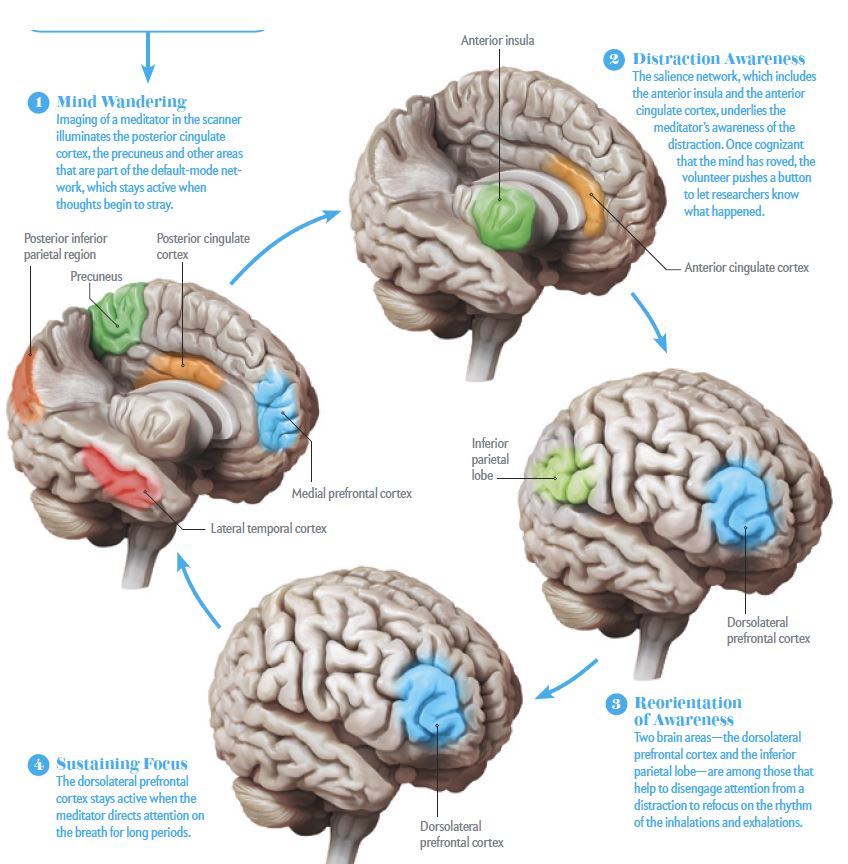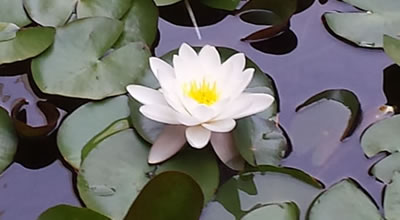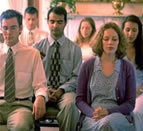This is a great graphic from an article in Scientific American showing the different regions of the brain that light up during the different phases of the meditative process. From focused attention, to mind wandering, to awareness of wandering and redirecting of attention.
Category Archives: Mindfulness and health
Work Life Balance is an Activity, Not an Event
Seeking Perfection in the Midst of Change
“Work Life Balance” is a popular theme in today’s always on and information-loaded workplaces. We are told that work and personal life are two powerful forces that we should strive to bring into balance with each other. As if work life balance were an external goal that can be realized if only we balance the scales properly. But life is always changing. Our jobs change, our colleagues change, the economy changes, industrial conditions change, our bodies change, our minds change, our families and friends change, the world changes….Is there anything in life that doesn’t change? And because conditions are always in flux, we will always need to make changes to our own personal scales of work life balance.
An Inner Equilibrium
Instead of thinking of work life balance as an external state to achieve, it may be more useful to think of it as an inner equilibrium that we can cultivate every moment we are alive. Like a tightrope walker who is constantly making micro-adjustments to keep from falling, work life balance becomes an ordinary activity that we can do all the time to make sure that we are living our lives sustainably.
To Understand What is Needed
An example of work life balance may be something as simple as remembering to notice your breath during a meeting, or turning off notifications on your smartphone when you get home from work, or driving to work without the radio on to build greater focus while you commute, or consciously choosing to say no to that event invite that is just one too many, or remembering to call old friends you’ve been wanting to catch up with, or deciding to put your work down and go for a walk. Above all, work life balance is about being sensitive enough in each moment to understand what is truly needed.
How Mindfulness is Short Changed in Popular Culture
The glib and tongue and cheek video from the BBC below is a good example of how mindfulness is being covered in the media. A lot of what is seen in this video is actually informative, but something is missing in its discussion of mindfulness which is also missing in other popular depictions of the practice. The typical way of presenting mindfulness is that it’s all about living in the now. As one of the subjects of the video says, a breath doesn’t take place in the past and it doesn’t take place in the future. A breath can only take place now. So mindfulness is about being aware in the present moment. But mindfulness is about more than awareness and the present moment. The sociologist in the video who criticizes mindfulness as a form of escapism likely doesn’t have a mindfulness practice himself; but he’s pointing to a flaw in how mindfulness is presented.
If mindfulness is just about being in the now, after all, how does that possibly help us deal with the practical challenges of living? Good question. The truth is that mindfulness has always been about two things: awareness and clear comprehension. Clear comprehension is a critical element in being mindful: it is our capacity to discern what is true in our direct experience, especially as it relates to suffering and freedom from suffering. When we are aware of our breath, we are not just aware of a featureless present moment, void of content; we are also aware of the patterns of our minds that cause us stress, panic, and pain. And because of this discerning aspect of mindfulness, the choices we make start changing in response to what we are learning about what causes suffering in our lives. Those new choices then start to change our lives in very practical ways. We see through old, unhealthy patterns and disidentify from them, thus giving ourselves freedom to choose a different course. Far from passive escapism, mindfulness is about choosing the appropriate response.
Like Clouds Passing
 The human mind is beautiful, but also dangerous. Our thoughts and emotions can be powerful drivers of our behavior. Since many of our mind-states are negative, our actions are often at the mercy of our thoughts. Gloomy and pessimistic thinking, long established from habit, creates rigid and stereotyped narratives psychologists have labeled cognitive distortions. You probably know some of these stories from your own experience. They often begin with, “I’ll never be good at this because,” or “I’ll never be loved because,” or “My pain will always be like this because,” etc. These stories become so familiar to us that they define who we think we are or can become. And the actions we take in the world reflect the limitations of this thinking.
The human mind is beautiful, but also dangerous. Our thoughts and emotions can be powerful drivers of our behavior. Since many of our mind-states are negative, our actions are often at the mercy of our thoughts. Gloomy and pessimistic thinking, long established from habit, creates rigid and stereotyped narratives psychologists have labeled cognitive distortions. You probably know some of these stories from your own experience. They often begin with, “I’ll never be good at this because,” or “I’ll never be loved because,” or “My pain will always be like this because,” etc. These stories become so familiar to us that they define who we think we are or can become. And the actions we take in the world reflect the limitations of this thinking.
But negative thinking itself isn’t the problem; it’s how we relate to our thinking that’s important.
One of the most powerful things about mindfulness practice is that it gives us the space to observe and witness the activity of our minds directly. With mindful awareness we see that thoughts come and go constantly, they can’t be held onto or controlled. We see that thoughts are not solid or fixed, that they are not our destiny, that they aren’t facts that force us to act, but are rather like clouds passing through the sky of awareness. With this perspective, which is cultivated through regular mindfulness practice, thoughts are seen to be ephemeral events in consciousness. When we see the impermanent nature of our thoughts, we begin to dis-identify with them. With this increased awareness, we have a choice about how we relate to our minds. And since thoughts and emotions drive much of our behavior, when we make the mindful choice to focus on thoughts that serve us instead of hurt us, our actions in the world will more likely be of benefit to ourselves and others.
Mindfulness and the Art of Giving Space
Talk: San Francisco Insight Meditation Community, May 24, 2015
The Suffering Equation
There’s an old expression in mindfulness circles: pain is inevitable, but suffering is optional. Life is inherently stressful and challenging, and we sensitive human beings are affected in many ways in body and mind by the daily slings and arrows of existence. Because there is pain in life, the way we relate to the pain is crucial. The following formula can help us sort out the difference between pain and suffering:
S=PxR
Where suffering (S) equals Pain (P) times Resistance (R). Pain is inevitable, but when we resist pain in our lives we cause more pain, because we experience the anguish and fear that comes when we deny and avoid what’s true. When we recognize our pain and allow it to be there, without resistance, we open to the possibility of responding to our pain in ways that ultimately bring healing.
Giving Space to the Joys and Sorrows of Life
Mindfulness is a simple yet profound way of being that essentially realigns our priorities.
We are told that we need to constantly be achieving things in order to be happy and living a successful life. And because of the non-stop busyness that drives so much of our behavior, our to-do lists, and progress in achieving our goals and plans, are what we focus on. As a result we ignore the very common signposts of human experience that tell us we are sentient beings living on this earth. The momentary joy of smelling a flower or eating a delicious meal or witnessing the smile of a child rush by us barely appreciated, or maybe completely missed, because our attention was occupied by thoughts of our next meeting or a project we have at work. Or, we miss the subtle clues inside our body that tell us that we are feeling sad, or anxious, or angry, or ill, and emotions seeking to be known and held in awareness are denied and distracted so that we don’t feel them. And deep intuitions that might guide us through life’s changes and point us to new ways of being are never given a chance to flower in the felt sense of the body because we ignore our bodies most of the time.

When we practice mindfulness, this all begins to change. Mindfulness is not a state of mind, or a technique, or a philosophy even. It is simply the act of giving space to what we experience as warm-blooded human beings. We give space to the old fears of not being good enough that have obsessed us all our lives, we give space to the anger that smolders inside when someone slights us, we give space to the old griefs that still have much to teach us. Giving space means letting the experience rise into consciousness, and holding it. Not changing it or fixing it, just holding it, letting it live in the light of awareness. Sometimes the pain and suffering we hold in awareness needs to be held for a long time – but eventually, what we hold in awareness will change. Its negative charge will lessen, or, as the Tibetans say, it will “self-liberate.” When the painful thought or emotion releases it will also give up its wisdom to us so that we will learn from it. Giving space to these all too human experiences allows us to metabolize the joys and sorrows of being alive. And what we cook in the cauldron of practice, given enough time, becomes the feast of our life.
Happiness is a Skill That We Can Learn
The pursuit of happiness is an idea deeply embedded in the American psyche, stretching back to the Declaration of Independence. But the idea of happiness is often distorted in our culture. We are told that happiness is about getting things. The right job, the nicest home, the best car, the perfect partner, etc. Yet lasting happiness isn’t about these things. It’s about how we experience our lives internally; it’s about how we respond to the physical sensations, thoughts, and emotions of our daily existence. Mindfulness practice points to the very real possibility that happiness is a skill that can be trained. Whether we train ourselves in an 8-week class in mindfulness-based stress reduction, or in our daily sitting practice, opening to the experience of the present moment – no matter what it contains – allows us to digest experiences while letting go of the stories we tell about them. This capacity to allow things to be as they are leads to more ease, peace, balance, well-being, and a sense of the richness of our lives – surely qualities that we can include in any definition of happiness. 
Why Mindfulness Will Survive the Backlash
An interesting piece from the Huffington Post. Apparently, 2015 is shaping up to be a year of backlash against mindfulness. But there’s no disputing the science.
“Despite the marketing of mindfulness as the latest hobby of the one percent, when it comes to the benefits of a meditation practice, the science is incontrovertible. A growing body of research unequivocally shows that a regular meditation practice is not only risk-free, but highly beneficial to the mind and body. Meditation has been shown to reduce symptoms of anxiety and depression, boost focus and improve sleep quality, among other benefits. And in just eight weeks, a meditation practice can create measurable brain changes in areas associated with memory, sense of self, empathy and stress.”
Full article is here.
